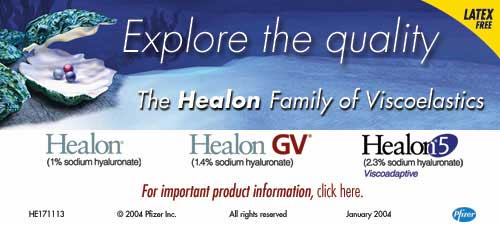
| |
Volume 4, Number 10
|
Monday, March 8, 2004
|

|
||

|
||
| Associations
Between Serum Lipoproteins and Severity of Diabetic Retinopathy
This study, a part of the Diabetes Control and Complications Trial/Epidemiology of Diabetes Interventions and Complications Study (DCCT/EDIC), aimed to determine associations between retinopathy status and detailed serum lipoprotein subclass profiles in people with Type 1 diabetes from the DCCT/EDIC cohort. Researchers from the University of Oklahoma, the Medical University of South Carolina and the University of Alabama studied 440 women and 548 men from the DCCT/EDIC cohort. They characterized retinopathy by Early Treatment Diabetic Retinopathy Study (ETDRS) scores, hard exudate scores and ETDRS scores minus the hard exudate component. They characterized lipoproteins by conventional lipid profile, nuclear magnetic resonance lipoprotein subclass profile (NMR-LSP), apoA1, apoB, lipoprotein(a) and susceptibility of low-density lipoprotein (LDL) to oxidation. Investigators then analyzed data with and without the following covariates: age, gender, duration of diabetes, HbA1c, albumin excretion rate, creatinine clearance, hypertension, body mass index, waist-hip ratio, DCCT treatment group and smoking status. The severity of retinopathy was positively associated with triglycerides (combined cohort) and negatively associated with high-density lipoprotein (HDL) cholesterol (men, combined cohort). NMR-LSP identified retinopathy as being positively associated with small and medium very low-density lipoprotein (VLDL) and negatively with VLDL size. In men only, retinopathy was positively associated with small LDL, LDL particle concentration, apoB concentration and small HDL; it was negatively associated with large LDL, LDL size, large HDL and HDL size. No associations were found with apoA1, Lp(a), or susceptibility of LDL to oxidation. All three measures of retinopathy revealed the same associations. Results of the study suggest that NMR-LSP reveals new associations between serum lipoproteins and severity of retinopathy in Type 1 diabetes. The data are consistent with a role for dyslipoproteinemia involving lipoprotein subclasses in the pathogenesis of diabetic retinopathy. |
|
SOURCE: Lyons, TJ, Jenkins AJ, Zheng D, et al. Diabetic retinopathy and serum lipoprotein subclasses in the DCCT/EDIC cohort. Invest Ophthalmol Vis Sci 2004;45:910-8. |
|

|
||
| Vitreous, Aqueous
and Plasma Concentration of Orally Administered Voriconazole A study conducted at Houston’s Cullen Eye Institute suggests that orally administered voriconazole, a new-generation triazole antifungal agent, achieves therapeutic aqueous and vitreous levels in the noninflamed human eye. It also suggests that the activity spectrum appears to appropriately encompass the most frequently encountered mycotic species involved in the various causes of fungal endophthalmitis. The prospective, nonrandomized clinical study included 14 patients scheduled for elective pars plana vitrectomy surgery between December 1, 2002, and February 28, 2003, at the Cullen Eye Institute. Researchers obtained and analyzed aqueous, vitreous and plasma samples from all patients after oral administration of two 400-mg doses of voriconazole taken 12 hours apart before surgery. They performed assays by means of high-performance liquid chromatography. Mean +/- SD voriconazole concentrations in plasma (14 patients), vitreous (14 patients) and aqueous (11 patients) were 2.13 +/- 0.93 µg/mL, 0.81 +/- 0.31 µg/mL and 1.13 +/- 0.57 µg/mL, respectively. Mean +/- SD sampling times after oral administration of the second voriconazole dose for plasma, vitreous and aqueous were 2.4 +/- 0.6 hours, 3.0 +/- 0.5 hours and 2.9 +/- 0.5 hours, respectively. The percentages of plasma voriconazole concentration achieved in the vitreous and aqueous were 38.1 percent and 53.0 percent, respectively. Mean vitreous and aqueous minimum inhibitory concentrations for 90 percent of isolates (MIC90) were achieved against a wide spectrum of yeasts and molds, including Aspergillus species and Candida species, as well as many other organisms. Authors of the study conclude that because of its broad spectrum of coverage, low MIC90 levels for the organisms of concern, good tolerability and excellent bioavailability with oral administration, voriconazole may represent a major advance in the prophylaxis or management of exogenous or endogenous fungal endophthalmitis. |
|
SOURCE: Hariprasad SM, Mieler WF, Holz ER, et al. Determination of vitreous, aqueous, and plasma concentration of orally administered voriconazole in humans. Arch Ophthalmol 2004;122:42-47. |
|

|
||
| Protease IV Activity
in P. aeruginosa Strains The protease IV gene and its product are common to P. aeruginosa, but not to other Pseudomonas species, according to a study by the Louisiana State University Eye Center and the LSU Health Sciences Center. Investigators aimed to determine the distribution of the protease IV gene, the production of this and other proteases by multiple strains of Pseudomonas and the virulence of a mutant that is specifically deficient in protease IV. They cloned the protease IV gene, analyzed its sequence and determined its chromosomal location using pulse-field gel electrophoresis. They conducted three polymerase chain reactions (PCRs) to detect the protease IV gene in 30 Pseudomonas isolates; they then determined protease production by Western blot analysis, colorimetric assay and zymography. They analyzed an allelic replacement mutant deficient in the protease IV gene for enzyme production, corneal growth and corneal virulence. The protease IV gene was identified in all P. aeruginosa, but none of the non-aeruginosa strains tested. The protease IV genes of strains PA103-29 and PAO1 were in a common chromosomal site and had 98.5 percent sequence identity, with variations occurring mainly in the promoter region. The protease IV activity of the 23 wild-type P. aeruginosa strains tested varied from 2.3 to 221.5 x 10-3 U/mg protein in the culture supernatant. Protease IV was produced by all P. aeruginosa wild-type strains. A protease IV-deficient mutant, derived from strain PA103-29, reduced virulence compared with its parent strain and unexpectedly produced alkaline protease. |
|
SOURCE: Caballero A, Thibodeaux B, Marquart M, et al. Pseudomonas keratitis: protease IV gene conservation, distribution, and production relative to virulence and other Pseudomonas proteases. Invest Ophthalmol Vis Sci 2004;45:522-30. |
|

|
||
| Orbital Radiotherapy
for Mild Graves’ Ophthalmopathy Radiotherapy is often used in Graves’ ophthalmopathy, but its efficacy has been doubted. In this study, Dutch researchers compared the efficacy of radiotherapy with sham irradiation in mild ophthalmopathy. In a double-blind randomized trial, 44 patients received orbital irradiation and 44 were sham-irradiated. The primary outcome was assessed using major and minor criteria. As secondary outcome, investigators used a disease-specific quality of life questionnaire (the GO-QoL) and compared cost-effectiveness and need for follow-up treatment. The primary outcome was successful in 23 of 44 (52 percent) irradiated patients vs. 12 of 44 (27 percent) sham-irradiated patients at 12 months after treatment. Radiotherapy was effective in improving eye muscle motility and decreasing the severity of diplopia. However, quality of life improved similarly in both groups. Those in the radiotherapy group had less need for follow-up treatment: 66 percent of this group required further treatment vs. 84 percent of the sham-irradiated patients. Retrobulbar irradiation did not prevent worsening of ophthalmopathy, which occurred in 14 percent of the irradiated and 16 percent of the sham-irradiated patients. The authors concluded that while radiotherapy is an effective treatment in mild ophthalmopathy, the improvement upon irradiation may not be associated with an increase in quality of life or a reduction in treatment costs. |
|
SOURCE: Prummel MF, Terwee CB, Gerding MN, et al. A randomized controlled trial of orbital radiotherapy versus sham irradiation in patients with mild Graves’ ophthalmopathy. J Clin Endocrinol Metabol 2004;89(1):15-20. |
|

|
||
BRIEFLY
|
|
|
||||||||||||||
| Subscriptions: Review of Ophthalmology Online
is provided free of charge as a service of Jobson Publishing, LLC. If
you enjoy reading Review of Ophthalmology Online, please tell a
friend or colleague about it. Forward this newsletter or send this address:
[email protected].
To change your subscription, reply to this message and give us your old
address and your new address; type "Change of Address" in the
subject line. If you do not want to receive Review of Ophthalmology
Online, reply to this message and type "Unsubscribe: Review of Ophthalmology
Online" in the subject line. Advertising: For information on advertising in this e-mail newsletter or other creative advertising opportunities with Review of Ophthalmology, please contact publisher Rick Bay, or sales managers James Henne, Michele Barrett or Lynn Grode. News: To submit news, send an e-mail, or FAX your news to 610.492.1049 |














